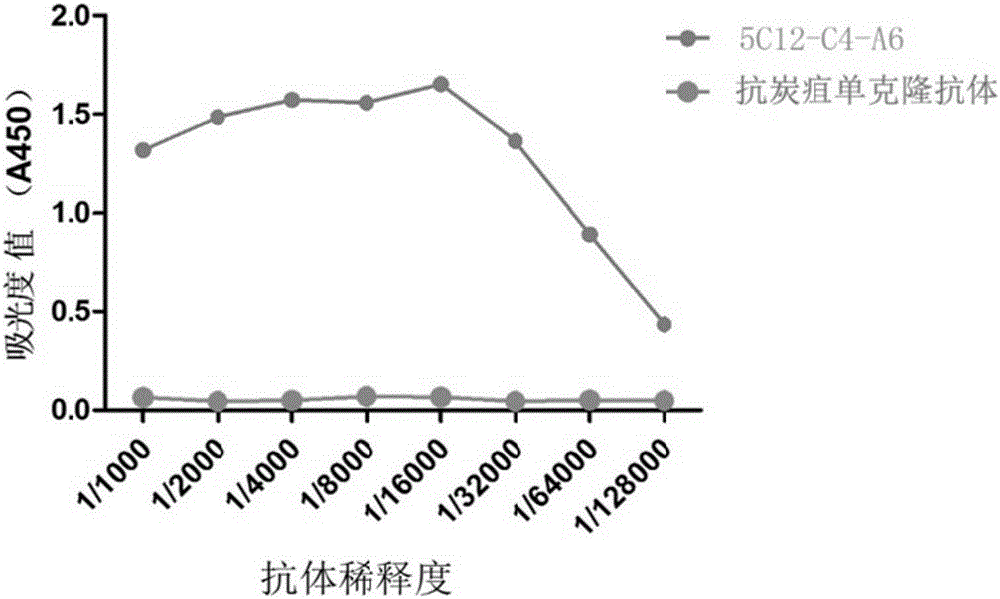Monoclonal antibody specifically binding to tandem epitope fusion proteins at second and fifth sites of LMP2A extracellular region and use thereof
A monoclonal antibody and fusion protein technology, applied in the field of biomedicine and immune targeted diagnosis and treatment, can solve the problems of reduced sensitivity to radiotherapy and chemotherapy, easy recurrence and metastasis, and unsatisfactory survival rate, and achieve high sensitivity and specificity. Effect
- Summary
- Abstract
- Description
- Claims
- Application Information
AI Technical Summary
Problems solved by technology
Method used
Image
Examples
Embodiment 1
[0023] Preparation and identification of anti-LMP2A monoclonal antibody:
[0024] 1. Antigen Immunization
[0025] Antigen emulsification: Freund's complete adjuvant was pre-heated slightly, sucked 200 μL into a 1 mL sterilized EP tube with a syringe, dripped 200 μL of purified LMP2A extracellular region epitope tandem fusion protein, and shaken while dripping until the emulsification was complete, inoculated into mice . Mice were immunized with complete Freund's adjuvant for the first time, and Freund's incomplete adjuvant for subsequent immunizations. Wherein the amount of adjuvant and protein is 1:1.
[0026] Initial immunization: After mixing 200 μL MP2A antigen (100 μg) with an equal amount of Freund’s complete adjuvant, 200 μL / mouse was subcutaneously injected into BALB / c mice at multiple points on the back of the neck and marked;
[0027] Booster immunization: mix the same dose of antigen with Freund's incomplete adjuvant, immunize every other week, the immunization ...
Embodiment 2
[0085] Analysis of immunological characteristics of anti-LMP2A monoclonal antibody:
[0086] Identification of Monoclonal Antibodies by Westernblotting
[0087] 1) Culture cells B95-8, SUNE, CNE, U937, NIH3T3 with 1640 medium containing 1% PS and 10% FBS. Cultured at 37°C, 5% CO 2 in the incubator.
[0088] 2) Observe the growth status of the cells every day, and change the medium regularly. The cells were immediately subcultured when they were congested, and some of them were frozen in liquid nitrogen.
[0089] 3) After the cells are congested, digest the cells with trypsin, collect the digested cells into a 15 mL centrifuge tube, and wash them 1-2 times with high-pressure sterilized PBS.
[0090] 4) Centrifuge at 1000 rpm for 5 min. repeat three times.
[0091] 5) The cell pellet was resuspended in 20 μL PBS, mixed with an equal volume of 2×loadingbuffer and heated, then loaded with a constant voltage of 80V for about 1 hour.
[0092] 6) Transfer to PVDF membrane, cur...
Embodiment 3
[0105] Detection of LMP2A expression in nasopharyngeal carcinoma tumor tissue by anti-LMP2A monoclonal antibody:
[0106] Immunohistochemical detection
[0107] 1) 33 cases of nasopharyngeal carcinoma were selected from the Second Affiliated Hospital of Nanjing Medical University and Jiangsu Cancer Hospital. The slices were 4 μm thick, baked in an oven at 60°C for 1 hour before dewaxing, and then dewaxed and hydrated.
[0108] 2) Wash with PBS 3 times, each time for 5min, H 2 o 2 Effect at room temperature for 5 to 10 minutes.
[0109] 3) After washing with PBS for 3 times, heat in a microwave oven at high temperature to restore the antigen.
[0110] 4) Rinse gently with PBS, soak in PBS for 5 minutes, repeat three times.
[0111] 5) Add 5% calf serum dropwise to block, block at room temperature for 30 minutes, shake off the serum, add the prepared monoclonal antibody 5C12-C4-A6 dropwise, dilute the antibody to a final concentration of 0.25 μg / mL, and use SP2 / 0 cell ascite...
PUM
 Login to View More
Login to View More Abstract
Description
Claims
Application Information
 Login to View More
Login to View More - R&D
- Intellectual Property
- Life Sciences
- Materials
- Tech Scout
- Unparalleled Data Quality
- Higher Quality Content
- 60% Fewer Hallucinations
Browse by: Latest US Patents, China's latest patents, Technical Efficacy Thesaurus, Application Domain, Technology Topic, Popular Technical Reports.
© 2025 PatSnap. All rights reserved.Legal|Privacy policy|Modern Slavery Act Transparency Statement|Sitemap|About US| Contact US: help@patsnap.com



